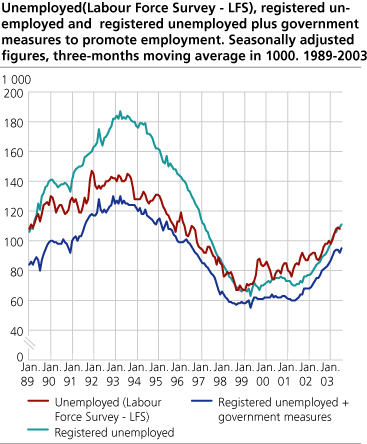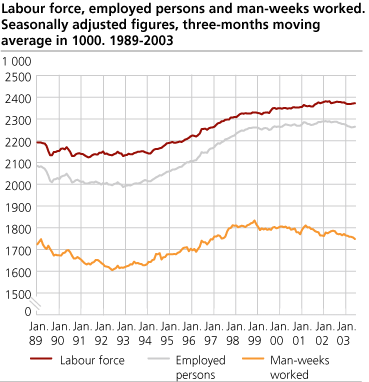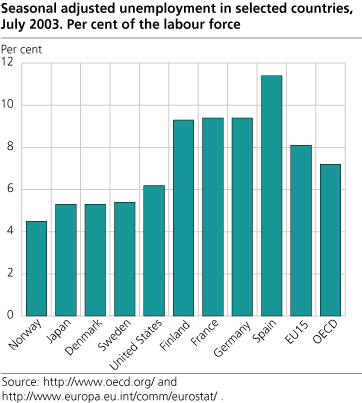Content
Published:
This is an archived release.
Unchanged unemployment and employment
The number of unemployed and employed persons remained approximately unchanged in the last three-months period. The figures are adjusted for seasonal variations.
Norwegian unemployment has gradually increased since the autumn 1999, according to seasonally adjusted figures from the Labour Force Survey (LFS). From the three-month period March-May to June-August this year total unemployment increased slightly by 3 000 people. In per cent of the labour force the number of unemployed persons increased by 0.1 percentage points, which is inside the error margins. Seasonally adjusted figures of registered unemployed persons at the Employment Offices showed a slight reduction in the last three-month period.
After a period of strong growth, the employment has just shown a slight increase from 1999, and last year the number of employed people started to fall. From the three-month period March-May to June-August 2003 the number of employed people decreased only by 1 000. This change is also within the margin of errors.
Small changes in unemployment also in the EU and OECD
The seasonally adjusted unemployment rate in Norway increased from 4.4 to 4.5 per cent between April and July 2003. In the same period the unemployment increased from 8.0 to 8.1 per cent as an average in the EU member countries. The unemployment rate in the OECD-countries as a whole went up from 7.1 to 7.2 per cent. In July 2003 the unemployment rate amounted to 6.2 in the USA, 0.2 percentage point higher than in April. The unemployment rate in Sweden increased from 5.3 per cent in April to 5.4 per cent in July 2003, in Denmark from 5.0 to 5.3 per cent, and in Finland from 9.2 to 9.3 per cent. In the same period unemployment stayed approximately unchanged in France and Germany. This is according to figures from OECD and Eurostat .
Man-weeks worked have shown a decreasing trend since the autumn 1999. The last three month period man-weeks worked decreased by 10 000, which is inside the margin of errors.
About the man-weeks estimates
Prior to 1996 there was only one survey week each month in the Norwegian LFS. In August in the reference year 1991 the survey week was the second week of the month, where the proportion on holiday was relatively high. The proportion of the population on holiday in August the years after 1995, when all weeks were surveyed, was a little lower compared with August 1991. Due to this, August has had too few leave substitutes since 1996. The employment figures for August this year were therefore adjusted upwards by 20 800 before seasonal adjustment. August last year this adjustment upwards was 17 500 leave substitutes.
Uncertain figures
Quality tests show that the seasonally adjusted LFS unemployment figures are uncertain. The seasonal-adjustment method has problems identifying a stable seasonal pattern for this series. The random component is relatively large compared with the seasonal component. The figures should therefore be used with caution.
The purpose of adjusting for seasonal variations is to describe the development during the last year and to give figures for change between the last two three-month periods, cleared for normal seasonal variations. In order to reduce uncertainty, the presented series are three months moving averages of the seasonally adjusted figures. For instance the figures for July is the average of the estimates from June, July and August.
Tables:
The statistics is published with Labour force survey.
Contact
-
Arbeidsmarked og lønn
E-mail: arbeidsmarked@ssb.no
-
Erik Herstad Horgen
E-mail: erik.horgen@ssb.no
tel.: (+47) 93 08 68 62



